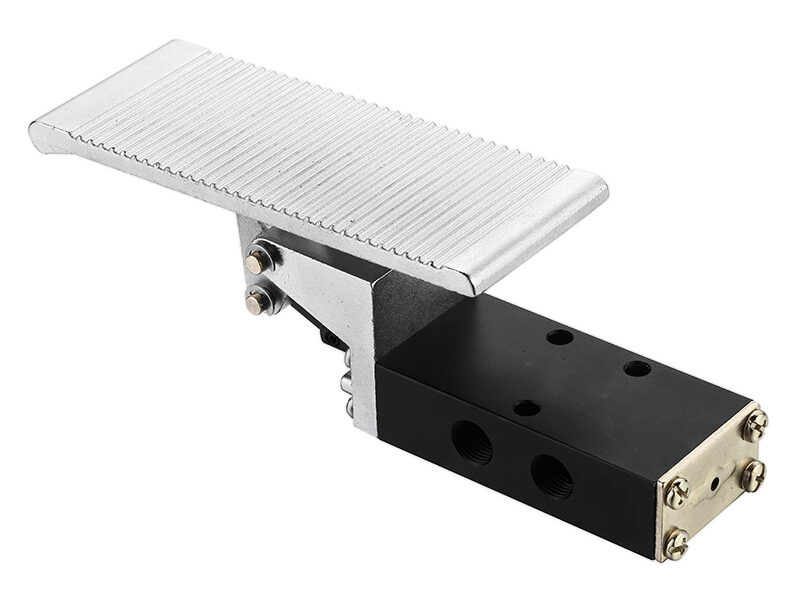Foot Operated Directional Valve | Control Air Flow by Foot for Hands-Free Operation. Explore our range of foot-operated directional valves. Easily control the directional shift of air flow with a foot pedal, freeing up hands for other tasks. They are the ideal choice for improving efficiency and safety on assembly lines, presses, and medical equipment. Select the right foot valve for your application now.
Besoin de produits pour votre projet ?
Nous comprenons que la recherche de sources d'approvisionnement peut être un défi.
Remplissez le formulaire avec vos articles spécifiques - n'hésitez pas à indiquer des composants uniques ou difficiles à trouver - soumettez votre demande et obtenez les solutions sur mesure que vous recherchez ! Oubliez les offres génériques ; nous sommes spécialisés dans la compréhension de vos besoins exacts et dans l'obtention de résultats qui vous vont comme un gant.
Empower your operators and streamline workflows with our robust foot-operated directional valves. Designed for applications where hands are occupied or for enhanced safety, these valves provide reliable, direct pneumatic control with simple foot actuation, boosting productivity and operator comfort.
Allows operators to control pneumatic systems while keeping their hands free for other tasks, improving workflow and efficiency.
Reduces operator strain and can be integrated into safety circuits, especially in machinery requiring coordinated hand and foot actions.
Robust construction with high-quality materials ensures long-lasting performance in tough industrial environments and frequent use.

Foot-operated directional valves provide a simple and effective way to control pneumatic circuits manually. Actuating the foot pedal directly shifts the valve spool or poppet, redirecting airflow to operate cylinders or other pneumatic devices. They are ideal for intermittent operations or where electrical control is not practical.
Constructed with high-strength materials to withstand repeated foot operation and harsh industrial conditions.
Precision-engineered internal valve components ensure positive sealing, low leakage, and consistent actuation over time.
Available with robust pedal guards to prevent accidental operation and protect the operator’s foot.
Standard port connections and mounting holes for straightforward integration into existing or new systems.
E.g., 3/2 NC, 3/2 NO, 5/2 (spring return or detented).
Common sizes like G1/4″, G3/8″, G1/2″.
Maximum and minimum pressure the valve can handle.
Indicates the valve’s air flow capacity.
Spring return, detented (latching), with or without guard.
Typically robust aluminum alloy or cast iron for durability.
Operating temperature range.
Floor mounting via base holes.
Pour les paramètres détaillés, veuillez vous référer aux manuels des produits individuels ou à l'adresse suivante consulter nos experts techniques.

For operator control of stamping, forming, or cutting operations where hands must be free to handle material.

Controlling clamping devices, small presses, or positioning tools, allowing operators to use both hands for assembly tasks.

Operating lifts, tilters, or simple conveying mechanisms where foot control is more convenient or safer.

Actuating clamps or positioners, allowing the welder to focus on the welding process with both hands.

Providing hands-free control for patient chairs, examination tables, or certain tool functions.

For controlling various machine functions where operators need to guide materials with their hands.
Always de-pressurize the pneumatic system before performing any maintenance on foot-operated valves.
Foot-operated valves are preferred when:
Foot-operated directional valves are commonly available in standard pneumatic valve functions:
The choice depends on the type of actuator being controlled and the desired circuit logic.
Yes, many of our foot-operated valve models are available with optional or integrated safety guards. These guards are designed to:
When selecting a foot-operated valve, please check the product specifications to see if a guard is included or available as an accessory for the specific model you are interested in.
This describes how the valve behaves after the pedal is pressed:
Choose spring return for momentary actions (e.g., jogging a cylinder) and detented for sustained actions (e.g., keeping a clamp engaged until manually released).
Foot-operated valves are generally robust, but like any mechanical device, they benefit from periodic maintenance:
Refer to the specific product manual for any model-specific maintenance recommendations.
Enhance operator efficiency and safety with our reliable and durable foot-operated directional valves. Explore our selection to find the ideal hands-free solution for your pneumatic control needs, or contact our experts for personalized assistance.

